DESIGNDASH: 俞孔坚2023年奥伯兰德国际风景园林奖获得者
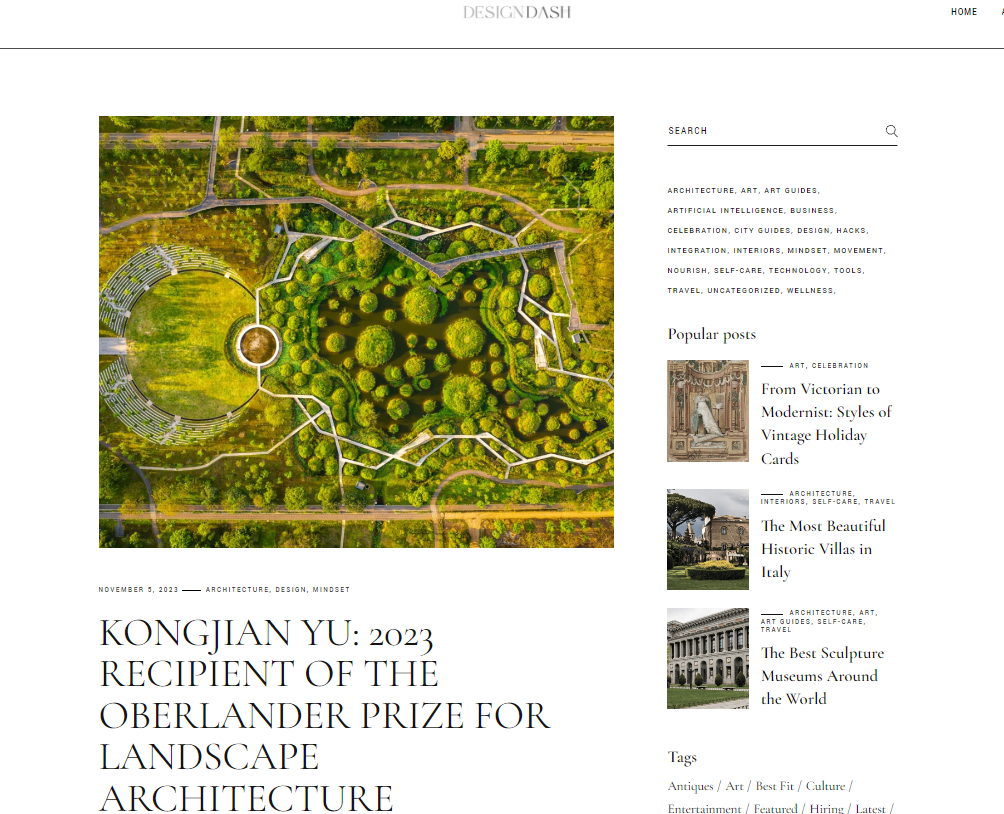
Kongjian Yu—the distinguished landscape architect renowned for his ecologically sound and culturally resonant designs—has been honored as the 2023 recipient of the Oberlander Prize for Landscape Architecture. This accolade—which commemorates the legacy of Cornelia Hahn Oberlander by recognizing individuals whose work contributes profoundly to the discipline—acknowledges Yu’s innovative integration of traditional Chinese aesthetic principles with contemporary sustainable practices. His transformative projects—which include the iconic Sponge City Initiative—not only mitigate urban environmental challenges but also elevate the social and spiritual well-being of the community—embodying the essence of sustainable urban development and ecological stewardship. Learn more about how Yu defines landscape architecture and why he is so worthy of the second biennial Oberlander Prize below.
ABOUT THE OBERLANDER PRIZE AND ITS WINNERS
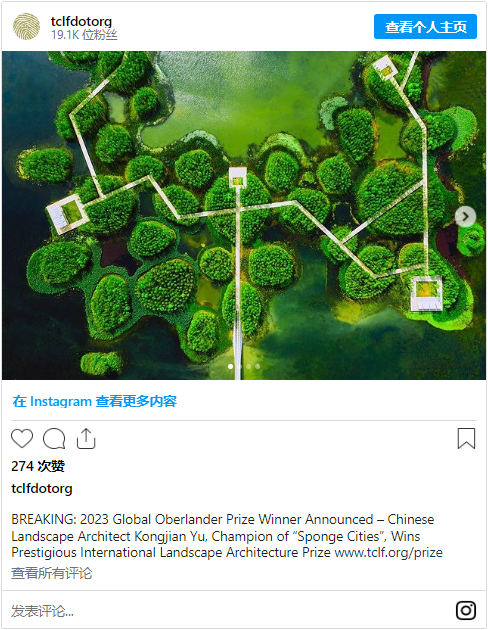
The Oberlander Prize for Landscape Architecture is a prestigious international award established by The Cultural Landscape Foundation (TCLF) to honor a living landscape architect or landscape designer whose body of work embodies the artistry, leadership, and commitment to the environment that Cornelia Hahn Oberlander exemplified over her esteemed career.
Cornelia Hahn Oberlander (1921–2021) was a pioneering landscape architect whose work was characterized by its sustainability, awareness of the social aspects of design, and integration with the natural environment. Born in Germany, Oberlander fled the Nazi regime and eventually settled in Canada, where she became one of the most influential figures in landscape architecture—advocating for green cities, environmentally conscious design, and children’s play spaces, among other things.
The Oberlander Prize—which is considered one of the highest honors in the field of landscape architecture—aims to raise public awareness of the profound influence that landscape architecture and its practitioners have on the environment and society. The award also includes a monetary prize of $100,000—given biennially to the laureate.
CRITERIA FOR NOMINATION AND RECEIPT OF THE OBERLANDER PRIZE
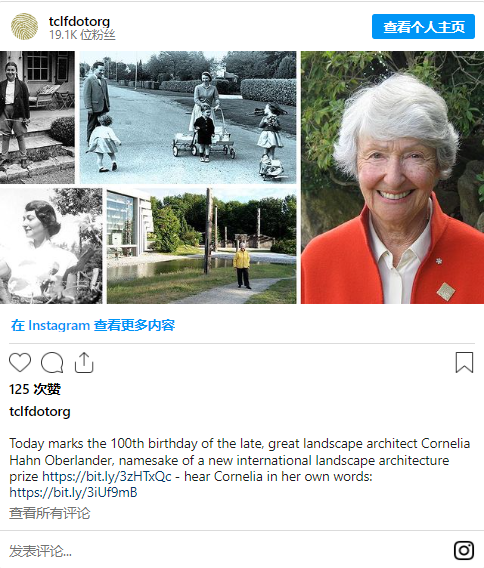
The criteria for the award reflect the values and achievements of Oberlander’s career—including design excellence, pioneering thinking, public engagement, a sustained body of work, and a lasting impact. Nominees for the prize are assessed by an independent jury of experts who consider these criteria.
The creation of the Oberlander Prize signals the growing recognition of landscape architecture as a discipline integral to the discussion and shaping of our environments, cities, and public spaces—especially in the context of global issues such as climate change, urbanization, and sustainability.
Oberlander Prize Recipients
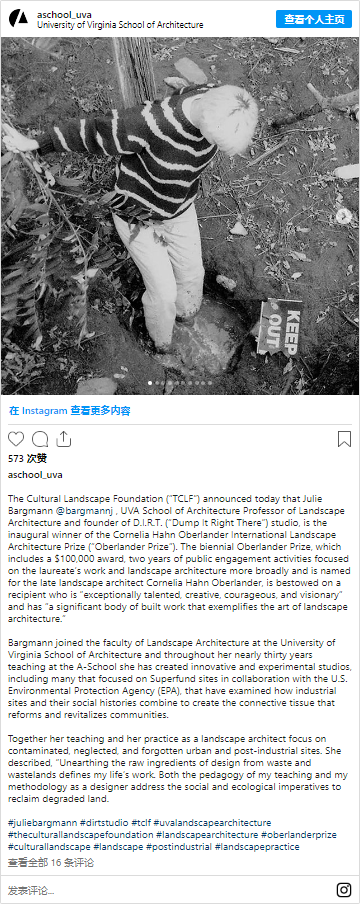
The first winner of the Cornelia Hahn Oberlander International Landscape Architecture Prize was announced in 2021 as landscape architect Julie Bargmann. Known for her innovative approach to the design of regenerative landscapes and her work on “industrial reuse,” Bargmann has been recognized for her transformative projects that revitalize contaminated and abandoned urban sites—turning them into places of beauty and utility.
Her work is characterized by a deep commitment to environmental sustainability and community engagement. Bargmann’s firm—D.I.R.T. Studio (Design Investigations Reclaiming Terrain)—has become synonymous with the revitalization of post-industrial landscapes, and she has been a leader in advocating for “working landscapes” that are both functional and inviting.
Receiving the Oberlander Prize is a testament to Bargmann’s pioneering work and its significant impact on the field of landscape architecture—echoing the values and ideals that Cornelia Hahn Oberlander espoused throughout her own groundbreaking career. It is also a testament to Kongjian Yu’s transformative work. Kongjian Yu is the 2023 winner of this prestigious award.
ABOUT PIONEERING LANDSCAPE ARCHITECT KONGJIAN YU
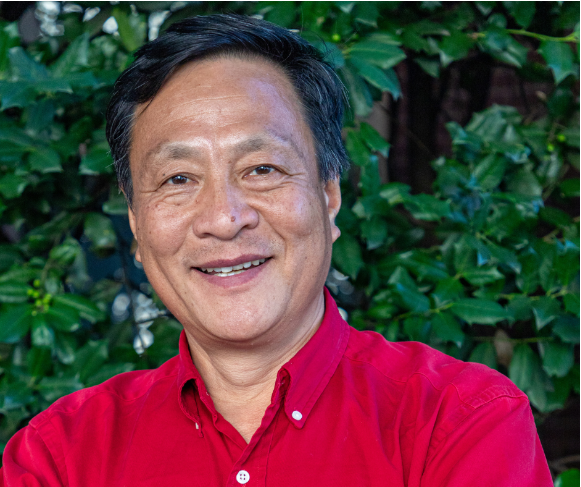
2023 Oberlander Prize Laureate Kongjian Yu, 2023. Photo ©Barrett Doherty courtesy of The Cultural Landsape Foundation.
Kongjian Yu is a prominent Chinese landscape architect known for his work in sustainable urban development and his innovative approach to landscape architecture that blends traditional Chinese aesthetics with modern ecological principles. He was born in 1963 in the Zhejiang province of China and has played a significant role in shaping contemporary landscape architecture in China and beyond.
EDUCATION AND ACADEMIC CAREER
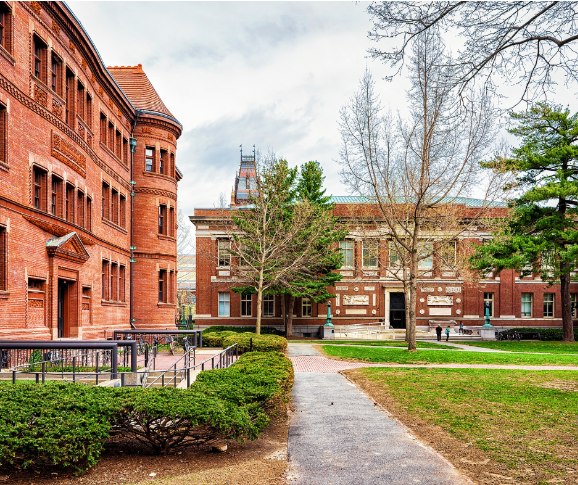
Yu received his Bachelor’s degree in landscape architecture from Beijing Forestry University and subsequently earned a Master’s degree and Ph.D. from Harvard University Graduate School of Design. His time at Harvard was influential in shaping his approach to landscape architecture—particularly his focus on sustainable and ecological design.
Harvard GSD is known for its rigorous academic environment and for producing leading professionals in the fields of landscape architecture, architecture, and urban design, and Yu’s education there certainly contributed to his later successes and philosophy in his professional life. His academic work is highly regarded—with a focus on the history of Chinese landscape architecture, ecological planning, and urbanization strategies.
PROFESSIONAL WORK
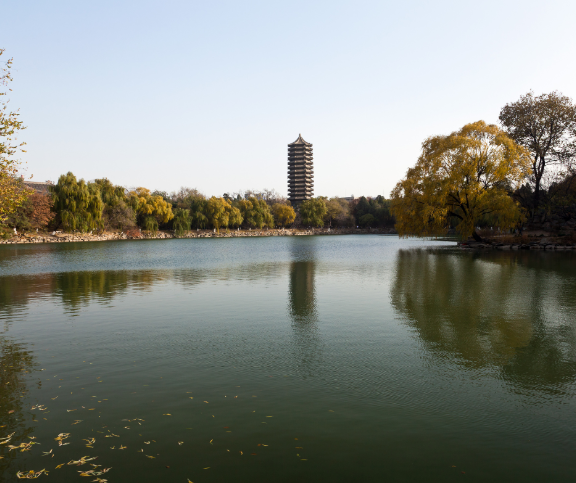
In 1997, Kongjian Yu founded the College of Architecture and Landscape Architecture at Peking University—aiming to bridge the gap between traditional Chinese landscape principles and modern ecological design. He is also the founder and principal of Turenscape—an internationally recognized landscape architecture and urbanism firm. Turenscape has completed numerous projects across China and has received quite a few international awards for its designs.
Through these institutions, Kongjian Yu has been able to exert significant influence on the landscape architecture profession. He has promoted an understanding of landscape architecture that is deeply rooted in ecological principles and cultural continuity—which is now echoed in the practices of new generations of architects, designers, and urban planners that emerge from Peking University and engage with Turenscape.
Founding the College of Architecture and Landscape Architecture at Peking University
Kongjian Yu’s initiative to establish the College of Architecture and Landscape Architecture at Peking University was a significant step in advancing the academic field of landscape planning and architecture in China. Before the establishment of this college, landscape architecture in China was not as prominent or developed as an academic discipline. Yu—through his global experience and vision—recognized the need for an institution that would educate future professionals in an integrated approach that would marry the principles of traditional Chinese landscaping with modern ecological and architectural practices.
Under his guidance, the college has become one of the premier institutions for architecture and landscape studies in China. It has played an increasingly important role in producing landscape architects who are well-versed in both the artistic and scientific aspects of landscape architecture. This educational foundation is crucial for addressing the complex challenges of urbanization, environmental degradation, and the preservation of cultural heritage within China and around the world.
Creating Turenscape
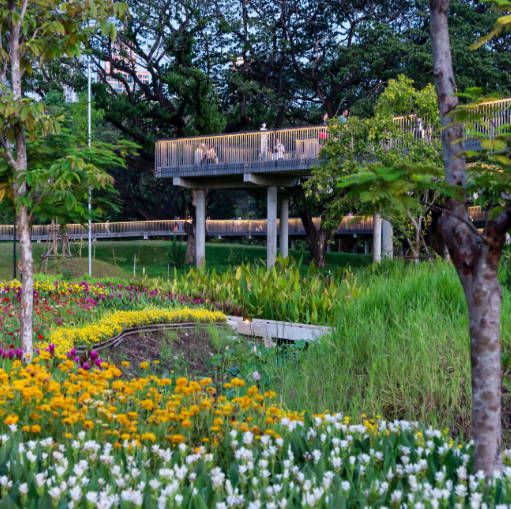
Benjakitti Forest Park, Bangkok, Thailand, 2022. Photo ©Turenscape courtesy of The Cultural Landscape Foundation.
Turenscape is a Beijing-based firm that Kongjian Yu founded in 1998. It has since become one of the most internationally recognized Chinese landscape architecture and urbanism firms. The company is notable for its large-scale ecological projects—which often transform neglected, derelict, or underutilized urban areas into vibrant, sustainable landscapes that serve both ecological and social functions.
Yu’s Turenscape is known for its pioneering work in creating “Sponge Cities”—which are designed to absorb and manage rainwater effectively through ecological methods—thereby addressing urban flooding and water scarcity issues. Projects by Turenscape often feature wetlands, natural water filtration systems, and the restoration of native plant life. These projects not only help to manage stormwater and improve the urban climate but also provide recreational and educational opportunities for local communities.
The work of Turenscape has been widely recognized for its innovation, sustainability, and resilience. It has garnered numerous international awards and has been influential in shaping global practices in landscape architecture. By employing a philosophy that tightly weaves together the fabric of nature and culture, Turenscape’s projects exemplify how public spaces can be both functional and beautiful—serving as models for ecological urban development.
PHILOSOPHY AND APPROACH
Yu’s design philosophy emphasizes the integration of natural elements into urban environments. He advocates for the creation of landscapes that are not only aesthetically pleasing but also functional in terms of ecology and sustainability.
KEY PROJECTS AND CONTRIBUTIONS
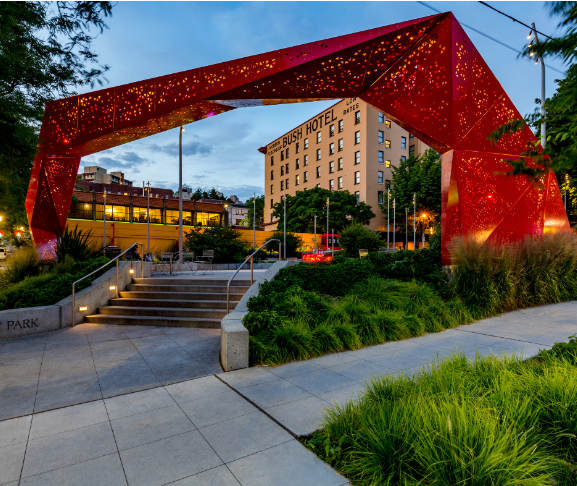
Hing Hay Park, Seattle, WA, 2018. Photo ©Miranda Estes courtesy of Turenscape and The Cultural Landscape Foundation.
As noted above, one of Yu’s most notable concepts is the “Sponge City”—a response to the challenges posed by urban flooding and water management. Sponge Cities are designed to absorb and reuse rainwater through natural processes—reducing the impact of floods and enhancing urban resilience to climate change.
Among his various influential projects, the Qunli Stormwater Park and the Houtan Park on the Shanghai Expo site are exemplary. These projects address ecological issues such as water filtration and flood control while also providing public recreational spaces.
Kongjian Yu’s influence extends beyond his own practice. He is a prolific author and lecturer—spreading his vision of ecological urbanism internationally. Yu was recently asked to give a keynote at the upcoming COP28 in Dubai.
He has received numerous accolades for his contributions to the field of landscape architecture, and his work continues to inspire sustainable design practices around the world. Below are two projects acknowledged by the Oberlander Prize award committee in their writeup about the landscape architect.
Zhongshan Shipyard Park, Zhongshan, China
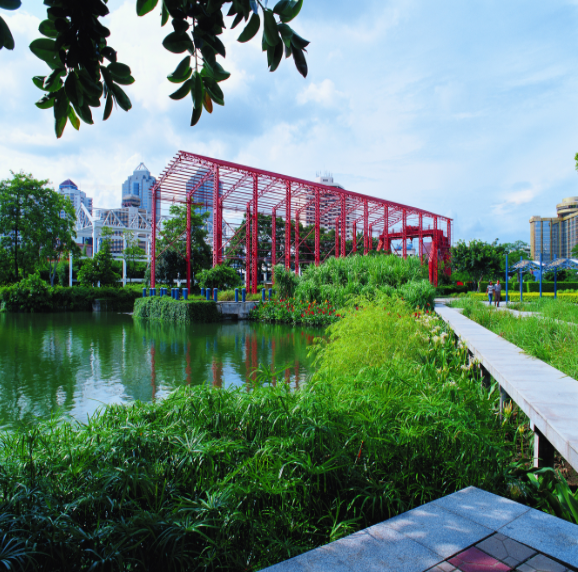
Zhongshan Shipyard Park, Zhongshan, Guandong Province, Chiina, 2011. Photo ©Turenscape courtesy The Cultural Landscape Foundation.
Zhongshan Shipyard Park is an example of how industrial heritage can be transformed into a public space while preserving historical elements. Once a derelict shipyard, this area was revitalized under Yu’s vision into a vibrant park that retains many of the shipyard’s original structures—such as tracks and cranes, integrating them into the landscape.
This project demonstrates Yu’s principle of “creative destruction” and “productive preservation”—where the site’s industrial past is both celebrated and ecologically rehabilitated. The park serves as a recreational space for the city while maintaining a connection to its industrial history.
Red Ribbon Park (Tanghe River Park), Qinhuangdao, China
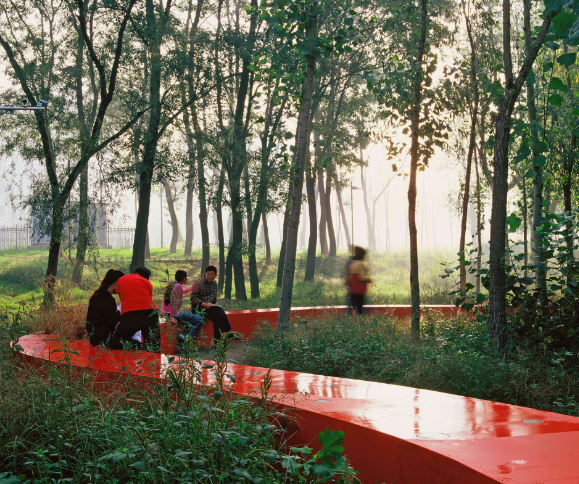
Red Ribbon Park, Qinhuangdao, Hebei Province, China, 2008. Photo ©Turenscape courtesy The Cultural Landscape Foundation.
The Red Ribbon Park—also known as Tanghe River Park—is notable for its iconic red ribbon that stretches across the park, a steel structure that functions as a bench, lighting framework, and an environmental interpretation device.
This project is lauded for its minimalist intervention in a natural setting, with the ribbon structure providing a strong visual element that guides visitors through the wetland landscape. It incorporates indigenous vegetation and ecological strategies to restore the river’s edge—enhancing biodiversity and improving the natural habitat.
ACKNOWLEDGMENTS AND AWARDS
Yu’s work has been recognized internationally—which is a testament to his creativity and the universal applicability of his ideas. He has won numerous awards beyond the Oberlander—including several from the American Society of Landscape Architects—highlighting his role as a global thought leader in the field.
Awarded the American Society of Landscape Architects (ASLA) Design Medal, Yu has been recognized by the ASLA for his exemplary work in landscape architecture. He was honored as a Young Global Leader by the World Economic Forum for his leadership and contribution to the field of sustainable urban planning.
Yu also received the International Federation of Landscape Architects (IFLA) Sir Geoffrey Jellicoe Award. This is the highest honor that the IFLA bestows upon a landscape architect. The award recognizes living landscape architects whose lifetime achievements and contributions have had an unparalleled, deeply-rooted impact on the welfare of society and the environment.
UNDERSTANDING YU’S PHILOSOPHICAL APPROACH TO LANDSCAPE ARCHITECTURE AND ECOLOGICAL INFRASTRUCTURE
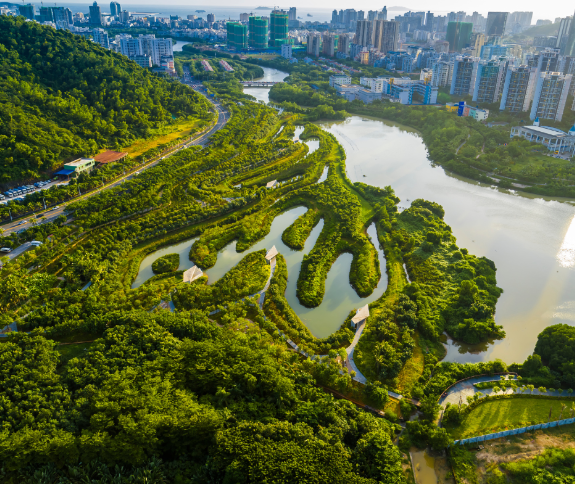
Sanya Mangrove Park, Sanya, Hainan Province, China, 2018. Photo ©Turenscape courtesy The Cultural Landscape Foundation.
Kongjian Yu’s philosophy is deeply rooted in the integration of ecological principles with landscape architecture—strongly influenced by traditional Chinese cultural concepts and contemporary environmental concerns.
Through his professional practice, academic leadership, and advocacy, Kongjian Yu exemplifies what it means to be a talented and visionary individual in the landscape architecture field. His work continues to inspire a balance between development and sustainability—reflecting a courageous commitment to ecological and cultural resilience.
Yu’s philosophy is both a response to the specific challenges of urban development in China and a universal call for sustainable design practices. He has been a vocal critic of the rapid—sometimes reckless—urbanization that neglects environmental health and local traditions.
His advocacy for the integration of ecological principles in design is not only about creating functional landscapes but also about ensuring these spaces are meaningful and connected to the cultural identity of the place. As we outline below, several key elements define his philosophical approach.
YU’S SPONGE CITY CONCEPT
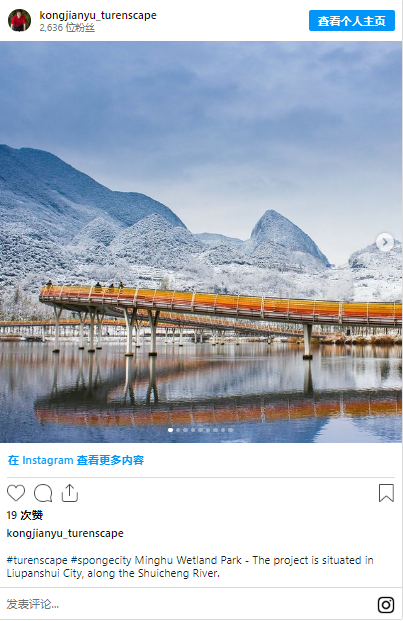
This is another cornerstone of Yu’s philosophy. He advocates for cities that mimic the natural water-absorbent properties of soil and vegetation. Sponge Cities are designed to be resilient to flooding, drought, and water pollution by integrating green roofs, permeable pavements, rain gardens, and restored wetlands into the urban fabric. This approach not only manages water sustainably but also creates valuable public spaces.
THE ART OF SURVIVAL
Yu believes that landscape architecture is not merely a matter of creating beautiful spaces. It is about the “art of survival.” He emphasizes that landscape design should solve critical environmental problems, such as flooding, pollution, and the urban heat island effect. It should focus on mitigating potentially destructive aspects of human activity. He advocates for designs that provide ecosystem services essential for both the environment and human well-being.
ECOLOGICAL INFRASTRUCTURE AND URBAN NATURE
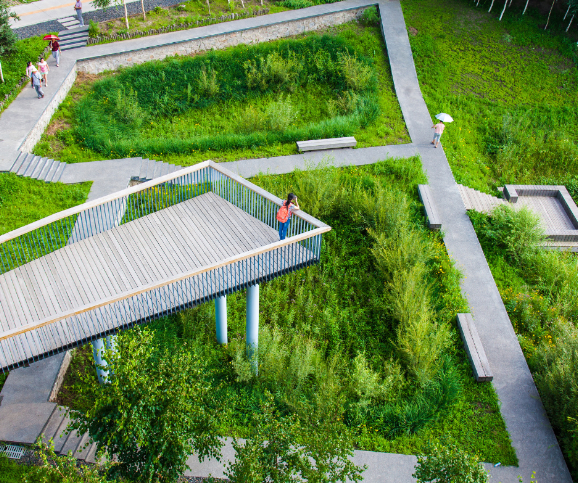
The Qunli Stormwater Park, Qunli New District, Haerbin City, Heilongjiang Province, China, 2014. Photo ©Turenscape courtesy The Cultural Landscape Foundation.
Instead of relying solely on engineered solutions for urban infrastructure, Yu suggests using ecological infrastructure. This involves using nature-based solutions for water management, air purification, and heat reduction in cities. He promotes the idea that green spaces are not just decorative elements that dot an urban landscape but integral components of a city’s infrastructure.
Ecological Security Patterns
Ecological security patterns refer to a strategic planning concept and approach that aims to ensure the sustainability and resilience of ecological systems amidst human development and land-use changes. The term gained prominence through Kongjian Yu.
This concept is based on the identification and preservation of critical ecological networks and natural processes that are essential for the functioning of healthy ecosystems. These patterns are often based on a deep understanding of local ecology and involve the mapping of land to identify key areas that provide important ecological services such as biodiversity habitats, flood regulation, water purification, and carbon sequestration.
Ecological security patterns are composed of interconnected natural areas including core conservation areas, ecological corridors, and buffer zones. By incorporating ecological security patterns into urban and regional planning, landscape architects and planners aim to create a sustainable balance between development and conservation. This involves setting aside significant tracts of land for nature within and around urban areas to form an interconnected network that supports ecological functions, promotes biodiversity, and helps to maintain ecological balance.
Core Conservation Areas, Ecological Corridors, and Buffer Zones
Core conservation areas are patches of land that are critical for maintaining the functionality of an ecosystem. They often include natural reserves, key biodiversity areas, or other important ecological sites that need strict protection.
Ecological corridors are areas that ensure connectivity between core areas—allowing for the movement of species and the flow of natural processes across the landscape. They are essential for maintaining genetic diversity and for the migration of species in response to climate change and habitat loss.
Buffer zones are transitional areas around core areas or corridors that provide additional protection and can have compatible and limited sustainable use. They help mitigate negative effects from human activities on the core conservation areas.
In the context of urban landscapes, this tripartite approach to urban development can lead to the creation of green infrastructure, such as parks, greenways, and urban forests—which not only contribute to the ecological health of the area but also provide recreational opportunities and aesthetic value for human inhabitants. The ultimate goal is to design and manage landscape urbanism in a way that secures the long-term health and safety of both natural systems and human communities.
PRODUCTIVE LANDSCAPE AESTHETICS
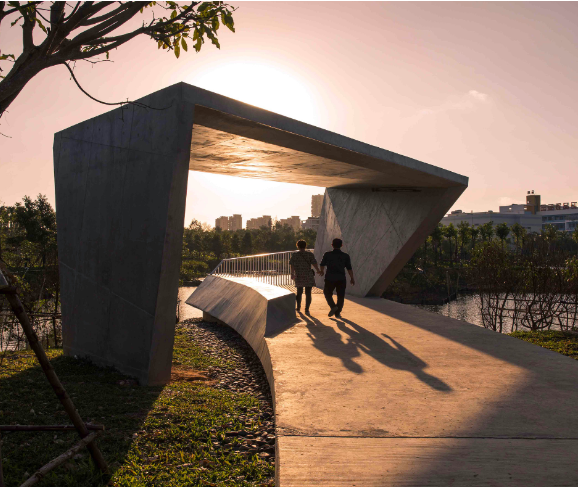
Sanya Mangrove Park, Sanya, Hainan Province, China, 2020. Photo ©Turenscape courtesy The Cultural Landscape Foundation.
Yu’s work often includes the concept of “productive aesthetics”—which means that a landscape should not only be beautiful but also productive in ecological terms. This involves landscape designers creating spaces that have agricultural, educational, or recreational functions that contribute to the sustainability and resilience of urban environments.
CULTURAL REFLECTION AND SYNTHESIS
He also emphasizes the importance of landscapes reflecting cultural heritage. Yu is critical of what he sees as the Western imitation in Chinese urban development and argues for design that is rooted in the local cultural and ecological context.
In this sense, Yu is a courageous contributor to landscape architecture. in the sense that he challenges By advocating for the incorporation of traditional Chinese landscape aesthetics into modern design, Yu must push against the tide of rapid urbanization and industrialization—which tends to favor quick, utilitarian designs over those that are sustainable and culturally resonant.
Yu’s influence extends beyond the design of individual projects to include a role in shaping national policies on urban development and green infrastructure—particularly through his advocacy for the Sponge City concept, which has been embraced by the Chinese government as a model for urban design.
FINAL THOUGHTS ABOUT OBERLANDER PRIZE WINNER KONGJIAN YU
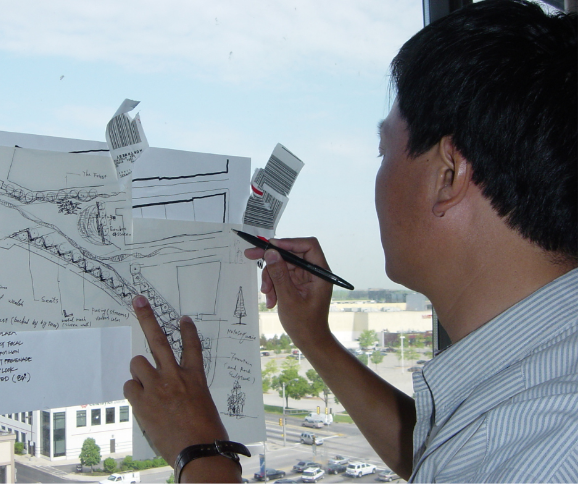
2023 Oberlander Prize Laureate Kongjian Yu sketching the concept for Chinatown Park, Boston, MA, 2003. Photo ©Turenscape courtesy The Cultural Landscape Foundation.
In bestowing the Oberlander Prize upon Kongjian Yu, the landscape architecture community not only celebrates his visionary work but also signals a broader recognition of the essential role that landscape architecture plays in addressing the pressing ecological challenges of our time. Yu’s career—a unique blend of innovation, environmental stewardship, and cultural resonance—is an awe-inspiring example for future generations of landscape architects.
His philosophy transcends aesthetic design—embedding functionality and sustainability within the urban fabric. His profound respect for nature within the anthropogenic sphere is quite clear. As the recipient of the 2023 Oberlander Prize, Yu’s enduring commitment to ‘healing the earth’ and his transformative contributions to landscape architecture resonate as a compelling manifesto for ecological and social responsibility—reflecting the essence of Cornelia Hahn Oberlander’s own pioneering spirit and enduring legacy.
Many thanks to The Cultural Landscape Foundation for the photos featured throughout this article.
